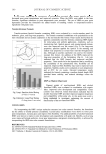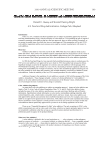COMPARISON OF DIFFERENT PEARL POWDERS 141 Evaluation of the moisturizing capacity of the skin, in general, encompasses (a) the capac- ity of water to pass through the skin, (b) the water content on the surface of the skin, and (c) the water-holding capacity of the skin. TEWL can be used to determine the ability of water to pass through the skin, whereas the water content is determined by the hydration state of the skin. The results of these two tests can be used to evaluate the water-holding capacity of the skin. There is no change in lipid content due to the pearl powder (data not shown). In evaluating the moisturizing effi ciency of the pearl powders, the results of TEWL showed that P-μ and P-w, similarly to Hya (Figure 1), show fi ne moisturizing per- formance and stratum corneum barrier function. P-μ has a distinctly stronger moisturiz- ing performance than P-w. This has provided scientifi c proof for the high effi ciencies of pearl powder in moisturizing, enhancing the water-holding capacity of the skin, and sup- porting skin care and resistance to aging. Tyrosinase (EC 1.14.18.1) catalyzes conversion of tyrosine to 3,4-dihydroxyphenylalanine (L-DOPA) and further oxidizes this to dopaquinone, which is ultimately used for the formation Figure 4. (A,B) Scavenging ability of three kinds of pearl powders on 1,1-dipheny1-2-picrylhydrazyl. Each value is expressed as mean ± SEM (n = 3). ***Signifi cantly different from P-w, p 0.001 (one-way ANOVA followed by Scheffe’s test).
JOURNAL OF COSMETIC SCIENCE 142 of melanin (14,24). Melanin formation is the most important determinant of mammalian skin color intensity. Consequently, inhibiting the formation of melanin may result in a reduction in skin darkness. Therefore, tyrosinase inhibitors have a proven potential for treating abnormal pigmentation disorders and as skin-whitening agents in the cosmetics industry. Several tyrosinase inhibitors, including arbutin and Ange-da, have been widely used for the purpose of whitening the skin, and some plant extracts, such as glycyrrhizae radix and morus radix, have also been used for the same purpose (24). There has been a concerted effort to search for naturally occurring tyrosinase inhibitors from plants. Plants represent a rich source of bioactive chemicals, many of which are largely free from harm- ful adverse effects (25,26), but their individual activity is not suffi ciently potent to be of practical use. However, pearl powder showed a strong inhibitory effect on the activity of mushroom tyrosinase, and any one of P-w, P-μ, or P-n can produce a tyrosinase resistance of 90% to 100%. Recently, safe and effective tyrosinase inhibitors have become important for their poten- tial applications in improving the quality of food, preventing pigmentation disorders, and preventing other melanin-related health problems in human beings (27,28). Further- more, tyrosinase inhibitors are also important in cosmetic applications for the whitening of skin because many men and women prefer a lighter skin color. Natural pearl powder may be able to effectively meet these demands. ROS are continuously produced during normal physiological events, and they can easily initiate the peroxidation of membrane lipids, leading to accumulation of lipid peroxides. However, they are removed by antioxidant defense mechanisms. Under pathological conditions, ROS are overproduced and result in oxidative stress. ROS are formed when endogenous antioxidant defense is inadequate. The imbalance be- tween ROS and antioxidant defense mechanisms leads to oxidative modifi cation in cellular membranes or intracellular molecules (29). There are many antioxidants that Figure 5. Chelating ability of three kinds of pearl powders on ferrous ion. Each value is expressed as mean ± SEM (n = 3).
Purchased for the exclusive use of nofirst nolast (unknown) From: SCC Media Library & Resource Center (library.scconline.org)





































































































































